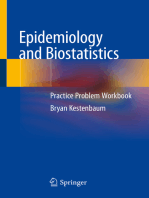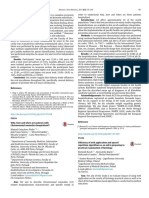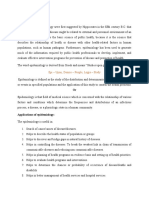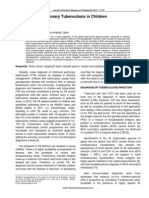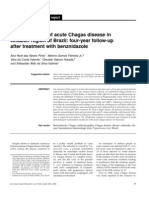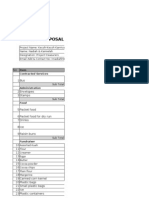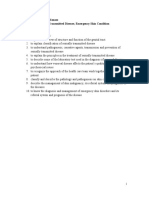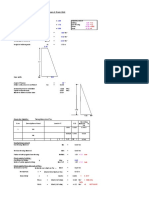Risk of Tuberculosis Infection Among Community Health Agents
Risk of Tuberculosis Infection Among Community Health Agents
Uploaded by
Luciana SaundersCopyright:
Available Formats
Risk of Tuberculosis Infection Among Community Health Agents
Risk of Tuberculosis Infection Among Community Health Agents
Uploaded by
Luciana SaundersOriginal Title
Copyright
Available Formats
Share this document
Did you find this document useful?
Is this content inappropriate?
Copyright:
Available Formats
Risk of Tuberculosis Infection Among Community Health Agents
Risk of Tuberculosis Infection Among Community Health Agents
Uploaded by
Luciana SaundersCopyright:
Available Formats
Rev Sade Pblica 2010;44(2)
Tiago Ricardo MoreiraI Eliana ZandonadeII Ethel Leonor Noia MacielII
Risk of tuberculosis infection among community health agents
ABSTRACT
OBJECTIVE: To estimate the risk of tuberculosis infection among community health agents involved in disease control. METHODS: A prospective cohort was followed up from April 2007 to May 2008 in the municipality of Cachoeiro de Itapemirim, Southeastern Brazil. The cohort was composed of 61 community agents, divided between unexposed individuals (n = 37) and exposed individuals (who were following up tuberculosis patients; n = 24). Over the 12-month follow-up, the tuberculin test was performed, using the tuberculin PPD RT23. The relative risk and 95% condence interval were calculated, and the correlation between tuberculin response and the agents occupational history was evaluated by means of Pearsons correlation. RESULTS: The incidence of the response was 41.7% in the exposed group and 13.5% in the unexposed group. The annual risk of infection was 52.8% in the exposed group and 14.4% in the unexposed group (p = 0.013). An association between tuberculin response and exposure to patients with tuberculosis was observed (RR = 3.08; 95% CI: 1.201;7.914). CONCLUSIONS: The agents who followed up tuberculosis patients during their routine work presented a greater risk of infection than did those who were not following up such patients. Implementation of routine administrative biosafety measures, among which the tuberculin test, should be prioritized, given the high risk of acquiring tuberculous infection among community health agents. DESCRIPTORS: Tuberculosis, nursing. Caregivers. Exposure to Biological Agents. Occupational Exposure. Occupational Risks. Community Health Centers.
Programa de Ps-Graduao em Sade Coletiva. Centro de Cincias da Sade (CCS). Universidade Federal do Esprito Santo (UFES). Vitria, ES, Brasil Ncleo de Doenas Infecciosas. CCS-UFES. Vitria, ES, Brasil
II
Correspondence: Ethel Leonor Maciel Ncleo de Doenas Infecciosas Centro de Cincias da Sade Universidade Federal do Esprito Santo Av. Marechal Campos, 1468 Maruipe 29040-091 Vitoria, ES, Brasil E-mail: emaciel@ndi.ufes.br Received: 12/20/2008 Revised: 8/7/2009 Approved: 9/8/2009
Tuberculosis infection among community health agents
Moreira TR et al
INTRODUCTION Tuberculosis (TB) is currently one of the most important causes of morbidity-mortality in the world,20 although it has been neglected in developing countries. Some studies3,6,7,9,10,13,17,18,a have dealt with healthcare professionals risk of infection and becoming ill with Mycobacterium tuberculosis. However, in Brazil, only one study has looked into this risk among community health agents (CHAs).14 As a means of facing up to the TB situation better, the National Tuberculosis Control Program (Programa Nacional de Controle da Tuberculose, PNCT) relies on the strategies of the Family Healthcare Program and CHAs for expanding the TB control actions. From this perspective, the actions of these teams enables improvements in adherence to treatment and reduces the dropout rate, through the possibility of expanding case detection.11 Care for TB patients is one of the activities performed by CHAs, and this presents a high risk of infection for these health professionals. This problem, which had been neglected for a long time, has now come back into discussion through several studies that have emphasized the increased risk of infection by M. tuberculosis among health professionals or students working in this eld.6,16 Studies3,4,13,19 have indicated that there is a greater risk of infection among professionals acting in healthcare establishments, and have drawn attention to length of service, delays in diagnosis and laboratory proof, professional category, working in certain locations (such as emergency services, hospital admission units and laboratories) and lack of respiratory protection (masks), as factors that may inuence the degree of contagion. However, none of these studies evaluated the risk of infection among CHAs. A study conducted recently in the municipality of Cachoeiro de Itapemirim, Southeastern Brazil, indicated that CHAs had a sixfold greater chance than did domestic employees (controls) of becoming infected with M. tuberculosis.14 In this light, the aim of the present study was to estimate the incidence of infection by M. tuberculosis among CHAs of the Family Healthcare Program. METHODS This was a prospective cohort study conducted between April 2007 and May 2008. It was composed of CHAs with and without exposure to TB patients within their professional activities. The estimated population of the municipality of Cachoeiro de Itapemirim, state of Esprito Santo, was 201,665 inhabitants in 2006, according to the Brazilian Institute for Geography and Statistics (Instituto Brasileiro de Geograa e Estatstica, IBGE).b This is a priority municipality for the PNCT,c,d given the high number of new cases and high incidence. In 2006, 94 new TB cases were notied in the municipality, corresponding to an incidence of 47.4 cases/100,000 inhabitants.e In March 2007, 196 CHAs were working in 19 Family Healthcare Units in the municipality. To calculate the sample size, the Epi Info 3.3.2 software was used. In the absence of studies with estimates of the strength of TB infection among CHAs, we used the odds ratio observed by Rodrigues et al (OR = 10).14 The test reaction rate in the unexposed group was taken to be 10%, with a test power of 80% and signicance level of 5%, for a ratio of exposed to unexposed cases of 1:1.5. With an allowance of 20% for possible losses, the minimum sample size was calculated as 21 CHAs for the exposed group and 34 for the unexposed group, thus totaling 55 CHAs. Four CHAs were drawn from each of the 19 municipal Family Healthcare Units. Out of the 76 individuals selected, four were excluded because they were off work due to health problems unrelated to TB. The remaining 72 underwent the tuberculin test. Of these, 11 CHAs presented strong reactions to the test and 61 had a negative result. These 61 CHAs were invited to participate in the study. Of these, 24 followed up TB patients and 37 did not follow up TB patients between the rst and second tests and in preceding years. To conrm whether the CHAs had been exposed to TB, the Municipal Tuberculosis Control Program supplied a list of names and addresses of TB patients who were undergoing treatment at the time of the study and over the preceding seven years. From these addresses, the microareas and respective primary healthcare units
a Silva JA. O agente comunitrio de sade do projeto qualis: agente institucional ou agente da comunidade? [tese de dourado]. So Paulo: Faculdade de Sade Pblica da USP; 2001. b Instituto Brasileiro de Geograa e Estatstica. Estimativas populacionais dos municpios em 2006. Disponvel em: http://www.ibge.gov.br/ home/estatistica/populacao/estimativa2006/POP_2006_DOU.pdf c Ministrio da Sade. Fundao Nacional de Sade. Controle da tuberculose: diretrizes do plano de ao emergencial para os municpios prioritrios. Braslia; 1997. d Ministrio da Sade. Secretaria de Vigilncia em Sade. Programa Nacional de Controle da Tuberculose. Braslia; 2002. e Ministrio da Sade. Secretaria de Vigilncia em Sade. Sistema Nacional de Vigilncia em Sade: relatrio de situao, Esprito Santo. 2. ed. Braslia; 2006
Rev Sade Pblica 2010;44(2)
were identied. The CHAs were then asked about visits to these patients homes, in order to conrm any such exposure. There was only one CHA for whom the exposure information diverged from the microarea information given by the control program, and this was because the CHA was new to the microarea and had not been responsible for following up the patient. This CHA was therefore excluded from the study. The following criteria were used for CHAs to be included in the study: a negative result in the tuberculin test and voluntary agreement to participate in the study. The exclusion criteria were: a positive result in the tuberculin test, a previous history of TB (during the last ve years),2 use of immunosuppressive treatment or vaccination with BCG within the last two years (self-reported). The data were collected by a trained interviewer, using a questionnaire consisting of closed questions seeking demographic and occupational data, clinical histories and exposure levels. The interviews were held during the visit when the tuberculin test results were given to the CHAs. The CHAs clinical histories were evaluated in relation to the following variables: previous TB treatment, booster dose of BCG, presence of BCG scar, use of medications, contact with TB patients outside of work settings and presence of family members with TB. Based on the information regarding exposure to TB cases within work settings, the CHAs were categorized as exposed or unexposed. CHAs who were conrmed as exposed were then asked to provide the following information: number of patients that they had followed up, number of patients that they were following up at that moment, number of visits per week made to each TB patients home, length of time for which they had been following up the TB patients (in months), whether they were using any protection measures and what these measures were. The tuberculin tests on the CHAs were performed using the tuberculin PPD RT23, applied intradermally in the middle third of the anterior face of the left arm. The tests were assessed 72 hours after the application, by a single professional with certication from the Ministry of Health. A millimeter ruler was used to measure the greatest diameter across the palpably hardened area, in accordance with the Manual of Tuberculosis Control Standards.a A hardened area greater than or equal to 10 mm in diameter was considered to represent a positive response to the tuberculin test. The test was applied by a professional who had been trained and certied by the State Health Department of Esprito Santo with a degree of concordance between readings of 94%. The tuberculin response (study outcome) was dened as an increase in the tuberculin response of at least 10 mm.6
a
Subjects who presented a tuberculin result < 4 mm (weakly reactive) were considered to be negative. The sample was formed by subjects with a mean age of 40 years and mean schooling level of ten years who were living in households with an average of three other people (Table 1). Women made up 98.4% of the sample (60) and men made up 1.6% (one individual). Regarding work location, 11 CHAs (18.0%) worked in the rural zone and 50 CHAs (82.0%) in the urban zone of the municipality. The groups were homogenous, without statistically signicant differences relating to the variables cited. The data were analyzed using the SPSS 12.0 software. For descriptive analyses on the quantitative variables, means and standard deviations were used, while for categorical variables, absolute and relative frequencies were used. The frequency measurement used was the accumulated incidence. The relative risk and 95% condence interval were calculated. The 2 test, or Fishers exact test when indicated, was used for association tests, while Students t test was used for comparisons between means. The signicance level was taken to be 5%. Furthermore, the correlation between the tuberculin response and the CHAs occupational history was evaluated by means of Pearsons correlation coefcient. The risk of infection with M. tuberculosis was calculated using the formula suggested by Rufno-Neto, expressed as a percentage:15 Where: N0 = number of individuals free from infection at the baseline; N = number of individuals who remained free from infection after the time t; t = time elapsed between the two tuberculin tests. The study project was authorized by the Municipal Health Department of Cachoeiro de Itapemirim and received approval from the Research Ethics Committee of the Centro de Cincias da Sade, Universdade Federal do Esprito Santo, under the number 127/06. All the participants signed a free and informed consent statement. RESULTS After following up the cohort for 12 months, 46 CHAs remained negative to the tuberculin test (75.4%): 14 in the exposed group and 32 in the unexposed group. Thus, the incidence of tuberculin response was 24.6% (15 CHAs), corresponding to 41.7% of the exposed group and 13.5% of the unexposed. The annual risk of infection was calculated as 52.8% in the exposed group and 14.4% in the unexposed group. Regarding clinical histories (Table 2), two CHAs reported that they had had previous treatment for TB,
Ministrio da Sade. Secretaria de Polticas Pblicas. Plano de Controle da Tuberculose no Brasil de 2001-2005. Braslia; 2007.
Tuberculosis infection among community health agents
Moreira TR et al
Table 1. Distribution of the study subjects (exposed and unexposed), according to age, schooling level (years) and number of people living in the household. City of Cachoeiro de Itapemirim, Southeastern Brazil, 2007-2008. Variable Age Schooling level (years) Number of people living in the household Exposed n=24 Mean (SD) 41.33 (9.22) 10.17 (1.31) 3.21 (1.47) Unexposed n=37 Mean (SD) 39.37 (11.25) 10.49 (1.91) 3.41 (1.30) 0.48 0.441 0.585 p
during childhood. Eighty-three percent of the individuals in the sample presented a BCG vaccination scar. Only eight CHAs had been revaccinated during the three years preceding the study, and one of these presented tuberculin conversion according to the criteria used. Presence of TB within the family during the past year was reported by one subject, and contact with TB outside of work settings was reported by 21 CHAs. Of these individuals, 66.7% were in the unexposed group. Thus, the results in Table 2 show that there was no relationship between the variables within the CHAs clinical history and their exposure. An association was observed between tuberculin response and exposure to TB patients (p = 0.013). The relative risk (RR) was 3.08 (95% CI: 1.20;7.91) times greater than in the unexposed group. Among the results presented in Table 3, it can be seen that there was no association between tuberculin response and the number of patients followed up or the number of visits per week made to TB patients homes (p > 0.05).
Only 5/24 (21%) of the CHAs said that they used any protection measures, i.e. keeping a distance from TB patients or remaining in ventilated locations during the visit. DISCUSSION CHAs are professionals who are trained to carry out disease prevention and health promotion activities through individual and collective actions at household and community levels, developed in accordance with the guidelines of the Brazilian National Health System (Sistema nico de Sade, SUS). Under supervision by the local administrator, CHAs act to advise and follow up families and communities with regard to caring for their own health.12 These professionals present special characteristics because they work within the communities where they live and become reference points for the populations of their areas.8 The reason why only a single study14 on occupational risks among CHAs was found through surveying the
Table 2. Variables within community health agents clinical histories in relation to exposure. City of Cachoeiro de Itapemirim, Southeastern Brazil, 2007-2008. Variable Previous TB treatment Yes Booster dose of BCG Yes Presence of BCG scar Yes Use of medication Yes Contact with TB patients outside of work settings Yes Presence of family members with TB Yes
a
Exposed n=24 n (%) 2 (8.3)
Unexposed n=37 n (%) -
0.150a 0.700a 0.726a 0.756 0.486 1.000a
4 (16.6)
4 (10.8)
21(87.5) 12 (50) 7 (29.3) -
30 (81.1) 20 (54) 14 (37.7) 1 (2.7)
Fishers exact test TB: tuberculosis BCG: Bacillus Calmette-Gurin
Rev Sade Pblica 2010;44(2)
Table 3. Correlation between response to tuberculin test among community health agents in the exposed group and their follow-up of patients with tuberculosis. City of Cachoeiro do Itapemirim, Southeastern Brazil, 2007-2008. Variable Length of time working as a community agent Number of patients that had been followed up Number of patients that were being followed up Length of time for which TB patients were being followed up Number of visits per week to the homes of TB patients Response (correlation coefcient) 0.131 0.258 0.152 0.138 0.332 p 0.316 0.223 0.241 0.289 0.124
literature may be the short time since CHAs were incorporated into TB control actions (since 2004).a The mean risk found in the two groups was 27.9%. This was similar to the result from Rodrigues et al,14 who found a prevalence of 26.7% among CHAs in Cachoeiro de Itapemirim, which was signicantly greater than their domestic worker controls (3.3%). One limitation of this study was the lack of a second tuberculin test performed two to three weeks after the rst one, to evaluate the booster phenomenon. The Centers for Disease Control and Prevention of the United States (CDC) recommend that when periodic tests are performed as annual monitoring on hospital personnel, individuals with a negative response to the initial skin test should repeat it one week later. This procedure avoids classication of false negatives.1 Oliveira et al13 found that the prevalence of the booster effect was 8.4% among the professionals of a university hospital in the city of Campo Grande, Centeral-Western Brazil. In a study among medical students at a university in Rio de Janeiro, Silva et al17 found a positive booster effect in 1.3%. This was similar to the result from Maciel et al,7 with a positive booster effect in 1%, among groups of medical, nursing and economics students at a university in Esprito Santo. Although this
last study7 was also carried out in the state of Esprito Santo, we cannot make the inference that those results from analysis of the booster effect could be extrapolated to our sample. The high proportion of CHAs who were following up TB patients or undertaking supervised treatment without using personal protection equipment reinforces the need to formulate public policies for this professional group. CHAs participation in combating TB has strengthened the ght against this disease, but it has exposed thousands of these professionals to a high risk of infection. This increased risk of infection by M. tuberculosis puts the benets of including these professionals in the TB combat program into question unless the preventive measures available are adopted. Moreover, the force of infection among the two study groups was greater than the force among the general population.5 Routine biosafety measures need to be implemented, given the high risk of tuberculous infection among CHAs. These measures include periodic tuberculin tests in accordance with the length of exposure and location of contact with patients and use of masks.
Ministrio da Sade. Secretaria de polticas Pblicas. Plano de controle da tuberculose no Brasil de 2001-2005. Braslia; 2007.
Tuberculosis infection among community health agents
Moreira TR et al
REFERENCES
1. Centers for Disease Control and Prevention. Guidelines for preventing the transmission of M. tuberculosis in health care facilities. MMWR Recomm Rep. 1994;43(RR-13):1-132. 2. Fox W, Ellard GA, Mitchison DA. Studies on the treatment of tuberculosis undertaken by the British Medical Research Council Tuberculosis Units, 19461986, with relevant subsequent publications. Int J Tuberc Lung Dis. 1999:3(10 Supl 2):231-79. 3. Franco C, Zanetta DMT. Tuberculose em prossionais de sade: medidas institucionais de preveno e controle. Arq Ci Saude. 2004;11(4):244-52. 4. Joshi R, Reingold AL, Menzies D, Pai M. Tuberculosis among health-care workers in low- and middle-income countries: a systematic review. PLoS Med. 2006;3(12): e494. DOI:10.1371/journal.pmed.0030494 5. Kusano MSE, Mendes IJM, Alves ED, Assis MCM. Risco anual da infeco tuberculosa no Distrito Federal (Brasil). Rev Bras Epidemiol. 2005;8(3):262-71. DOI:10.1590/S1415-790X2005000300008 6. Maciel EL, Viana MC, Zeitoune RC, Ferreira I, Fregona G, Dietze R. Prevalence and incidence of Mycobacterium tuberculosis infection in nursing students in Vitria, Esprito Santo. Rev Soc Bras Med Trop. 2005;38(6):469-72. DOI:10.1590/S003786822005000600004 7. Maciel EL, Meireles W, Silva AP, Fiorotti K, Dietze R. Nosocomial Mycobacterium tuberculosis transmission among healthcare students in a high incidence region, in Vitria, State of Esprito Santo. Rev Soc Bras Med Trop. 2007;40(4):397-9. DOI:10.1590/S003786822007000400004 8. Maciel ELN, Vieira RCA, Milani EC, Brasil M, Fregona G, Dietze R. O agente comunitrio de sade no controle da tuberculose: conhecimentos e percepes. Cad Saude Publica. 2008;24(6):1377-86. DOI: 10.1590/S0102-311X2008000600018 9. Maciel ELN, Prado TN, Fvero JL, Moreira TR, Dietze R. Tuberculose em prossionais de sade: um novo olhar sobre um antigo problema. J Bras Pneumol. 2009;35(1):83-90. DOI: 10.1590/S180637132009000100012 10. Minayo MCS, D`Elia JC, Svitone E. Programa Agentes de Sade do Cear: Estudo de Caso. Fortaleza: Fundo das Naes Unidas para a Infncia; 1990. 11. Muniz JN, Palha PF, Monroe AA, Gonzales RC, Rufno Netto A, Villa TCS. A incorporao da busca ativa de sintomticos respiratrios para o controle da tuberculose na prtica do agente comunitrio de sade. Cienc Saude Coletiva. 2005;10(2):315-21. DOI: 10.1590/S1413-81232005000200009 12. Nunes M O, Trad LB, Almeida BA, Homem CR, Melo MCIC. O agente comunitrio de sade: construo da identidade desse personagem hbrido e polifnico. Cad Saude Publica. 2002;18(6):1639-46. DOI: 10.1590/S0102-311X2002000600018 13. Oliveira SMVL, Honner MR, Paniago AMM, Aguiar ESA, Cunha RV. Prevalncia da infeco tuberculosa entre prossionais de um hospital universitrio. Rev Latino-Am Enfermagem.2007;15(6):1120-4. DOI: 10.1590/S0104-11692007000600010 14. Rodrigues PM, Moreira TR, Moraes AKL, Vieira RCA, Dietze R, Lima RCD, et al. Infeco por Mycobacterium tuberculosis entre agentes comunitrios de sade que atuam no controle da TB. J Bras Pneumol. 2009;35(4):351-8. DOI: 10.1590/ S1806-37132009000400009 15. Rufno-Neto A. Modelos Epidemiomtricos em tuberculose denio de estados de risco de infeco. Rev Saude Publica. 1977;11(2):188-98. DOI: 10.1590/S0034-89102006000200004 16. Sepkowitz KA, Schluger NW. Tuberculosis and the health care worker. In: Davis AL, editor. Tuberculosis. New York: Browand Company. 1996. p. 935-43. 17. Silva VM, Cunha AJL, Oliveira JR, Figueira MM, Nunes ZB, DeRiemer K, Kritski AL. Medical students at risk of nosocomial transmission of Micobacteriun Tuberculosis. Int J Tuberc Lung Dis. 2000;4(5):420-6. 18. Silva VMC, Cunha AJLA, Kritski AL. Risco de infeco pelo Mycobacterium tuberculosis entre alunos da Faculdade de Medicina da Universidade Federal do Rio de Janeiro. J Bras Pneumol. 2004;30(5):459-66. DOI: 10.1590/S1806-37132004000500010 19. Sociedade Brasileira de Pneumologia e Tisiologia. II Diretrizes Brasileiras para Tuberculose. J Bras Pneumol. 2004;30(1):86. 20. World Health Organization. Global tuberculosis control: surveillance, planning, nancing. WHO Report 2007. Geneva; 2007. (WHO/HTM/ TB/2007.376).
Research funded by the Ministry of Science and Technology, National Council for Scientic and Technological Development, Ministry of Health (Announcement 25/2006: Neglected Diseases Study) and the International Clinical Operational and Health Services Research and Training Award (Announcement ICOHRTA 5 U2R TW006883-02). Article based on the masters dissertation of Moreira TR, presented within the Postgraduate Public Health Program of the Universidade Federal do Esprito Santo, in 2008.
You might also like
- As in The Counselling RoomDocument4 pagesAs in The Counselling Roomandrei crisnic100% (1)
- Typical Circuit Diagram of Star Delta StarterDocument3 pagesTypical Circuit Diagram of Star Delta StarterAhmed Taha100% (1)
- JTLD 27 03 10 - 1..8Document9 pagesJTLD 27 03 10 - 1..8Reixel Raquel MugruzaNo ratings yet
- Factors Associated To RelapseDocument8 pagesFactors Associated To RelapseEpi PanjaitanNo ratings yet
- Fetch ObjectDocument7 pagesFetch ObjectBilly UntuNo ratings yet
- 1 s2.0 S2173511517301550 MainDocument6 pages1 s2.0 S2173511517301550 MainHermenegildo chitumbaNo ratings yet
- Characteristics of Leprosy Diagnosed Through The Surveillance of Contacts: A Comparison With Index Cases in Rio de Janeiro, 1987-2010Document6 pagesCharacteristics of Leprosy Diagnosed Through The Surveillance of Contacts: A Comparison With Index Cases in Rio de Janeiro, 1987-2010Ajie WitamaNo ratings yet
- September CDC HAISDocument11 pagesSeptember CDC HAISnoval firdausNo ratings yet
- download (1)Document7 pagesdownload (1)paulsmallriverNo ratings yet
- 1471-2334-13-538Document8 pages1471-2334-13-538Muhammad AliNo ratings yet
- LepraDocument5 pagesLepraLilianPrasetyaNo ratings yet
- Jurnal TBC Inter 1Document5 pagesJurnal TBC Inter 1sekti lindaNo ratings yet
- Risk Factors For Pulmonary TuberculosisDocument8 pagesRisk Factors For Pulmonary TuberculosisYet Barreda BasbasNo ratings yet
- Tuberculosis Infection Control Practices and AssocDocument12 pagesTuberculosis Infection Control Practices and AssocchalachewNo ratings yet
- Predictors of Medication Adherence PPT ProposalDocument19 pagesPredictors of Medication Adherence PPT ProposalKeana DacayanaNo ratings yet
- Raghavendra Yarlagadda Temesgen Mulugeta Fanta Gashe Ramanjireddy Tatiparthi.Document18 pagesRaghavendra Yarlagadda Temesgen Mulugeta Fanta Gashe Ramanjireddy Tatiparthi.yraghavendraNo ratings yet
- DK 1Document5 pagesDK 1Isnila F. KelilauwNo ratings yet
- Reference ThesisDocument13 pagesReference ThesisGhina SalsabilaNo ratings yet
- Intensity of Exposure To Pulmonary Tuberculosis Determines Risk of Tuberculosis Infection and DiseaseDocument10 pagesIntensity of Exposure To Pulmonary Tuberculosis Determines Risk of Tuberculosis Infection and DiseaseYu YuNo ratings yet
- Mycobacterium Tuberculosis Latent Infection in Healthcare Students Systematic Review of PrevalenceDocument11 pagesMycobacterium Tuberculosis Latent Infection in Healthcare Students Systematic Review of PrevalenceJaqueline OliveiraNo ratings yet
- Hiv Sul InglesDocument7 pagesHiv Sul Inglesandrea azevedoNo ratings yet
- Group One ProjectDocument37 pagesGroup One Projectgamatvictor7No ratings yet
- AEP Vol. 15, No. 8 Abstracts (Ace) September 2005: 630-665Document1 pageAEP Vol. 15, No. 8 Abstracts (Ace) September 2005: 630-665Aoy RangsimaNo ratings yet
- 98668Document6 pages98668SyedFaridAliNo ratings yet
- Journal 1Document7 pagesJournal 1anonymousNo ratings yet
- Ambo UniversityDocument12 pagesAmbo UniversityArarsa TolasaNo ratings yet
- A02v40n5 2 PDFDocument6 pagesA02v40n5 2 PDFrestu anindityaNo ratings yet
- 1 Line Treatment Outcomes of The New Pulmonary Bacteriologically Confirmed TB Cases (2012 Cohort, %)Document34 pages1 Line Treatment Outcomes of The New Pulmonary Bacteriologically Confirmed TB Cases (2012 Cohort, %)ComingSoonNo ratings yet
- Tugas Ulang Metodologi PenelitianDocument55 pagesTugas Ulang Metodologi PenelitianMuhammad Candra R.ANo ratings yet
- Early Initiation of ARV Therapy Among TB-HIV Patients in Indonesia Prolongs Survival Rates!Document9 pagesEarly Initiation of ARV Therapy Among TB-HIV Patients in Indonesia Prolongs Survival Rates!Ayu DinafebrianiNo ratings yet
- Early Initiation of ARV Therapy Among TB-HIV Patients in Indonesia Prolongs Survival Rates!Document6 pagesEarly Initiation of ARV Therapy Among TB-HIV Patients in Indonesia Prolongs Survival Rates!Eka CintyaNo ratings yet
- Tuberculosis: Patient Profile, Service Flowchart, and Nurses' OpinionsDocument5 pagesTuberculosis: Patient Profile, Service Flowchart, and Nurses' OpinionsJames 'jps' SimanjuntakNo ratings yet
- Guia IDSA - Clostridium DifficileDocument29 pagesGuia IDSA - Clostridium DifficileLuisFelipeDeLaCruzArmijoNo ratings yet
- Risk Factors Associated With TB, A Case-Control Study in A Chinese PopulationDocument7 pagesRisk Factors Associated With TB, A Case-Control Study in A Chinese PopulationElliNo ratings yet
- Maternal, Fetal, and Neonatal Outcomes in Pregnant Dengue Patients in MexicoDocument8 pagesMaternal, Fetal, and Neonatal Outcomes in Pregnant Dengue Patients in MexicoLola del carmen RojasNo ratings yet
- Carriage Rate and Effects of Vaccination After Outbreaks of Serogroup C Meningococcal Disease, Brazil, 2010Document6 pagesCarriage Rate and Effects of Vaccination After Outbreaks of Serogroup C Meningococcal Disease, Brazil, 2010Mark ReinhardtNo ratings yet
- Mm6819a3 HDocument5 pagesMm6819a3 Hje8aNo ratings yet
- Assessment of Knowledge, Attitudes and Perceptions Regarding Ebola Disease in Healthcare Workers From A Tertiary Care Hospital in RomaniaDocument9 pagesAssessment of Knowledge, Attitudes and Perceptions Regarding Ebola Disease in Healthcare Workers From A Tertiary Care Hospital in RomaniaAli GhanemNo ratings yet
- Efficiency of Web Application and Spaced Repetition Algorithms As An Aid in Preparing To Practical Examination of HistologyDocument2 pagesEfficiency of Web Application and Spaced Repetition Algorithms As An Aid in Preparing To Practical Examination of HistologyduffuchimpsNo ratings yet
- Cohorte 10 PDFDocument7 pagesCohorte 10 PDFLaura MottaNo ratings yet
- Nihms 1587191Document13 pagesNihms 1587191Vnime MusicNo ratings yet
- Molecular Diagnosis of TB in The HIV Positive PopulationDocument10 pagesMolecular Diagnosis of TB in The HIV Positive PopulationajengzahraaaNo ratings yet
- Sobretratamiento de Neumonia.2013.EditorialDocument2 pagesSobretratamiento de Neumonia.2013.EditorialluchititaNo ratings yet
- 1 s2.0 S0264410X1501470X MainDocument8 pages1 s2.0 S0264410X1501470X MainSheron Jude SeneviratneNo ratings yet
- Tuberculosis and Incarceration Uncovering the BroDocument2 pagesTuberculosis and Incarceration Uncovering the Brosivagurunathan.schoolNo ratings yet
- Moreira Silva 2015Document11 pagesMoreira Silva 2015Javier ÁngelesNo ratings yet
- 1 Mortality Among Hospitalized Dengue Patients With Comorbidities in Mexico Brazil and ColombiaDocument8 pages1 Mortality Among Hospitalized Dengue Patients With Comorbidities in Mexico Brazil and Colombiarommelbasket08No ratings yet
- Protective Effect of Breast Milk On Urinary Tract Infection in Children Aged 0-3 YearsDocument5 pagesProtective Effect of Breast Milk On Urinary Tract Infection in Children Aged 0-3 YearsChika FebrianiNo ratings yet
- BMC Public Health: Risk Factors For Pulmonary Tuberculosis: A Clinic-Based Case Control Study in The GambiaDocument7 pagesBMC Public Health: Risk Factors For Pulmonary Tuberculosis: A Clinic-Based Case Control Study in The Gambiapuskesmas beloNo ratings yet
- Rockson Ohene Asante 2235026 - Epidemiology Assignment by Pratap Kumar Jena SirDocument11 pagesRockson Ohene Asante 2235026 - Epidemiology Assignment by Pratap Kumar Jena SirRockson Ohene Asante100% (1)
- EpidemiologyDocument7 pagesEpidemiologyInoxcent Moon100% (1)
- Knowledge, Attitudes and Practices On HIV/AIDS and Prevalence of HIV in The General Population of Sucre, BoliviaDocument13 pagesKnowledge, Attitudes and Practices On HIV/AIDS and Prevalence of HIV in The General Population of Sucre, BoliviaRima AnggreniNo ratings yet
- DiagnosisofpulmonaryTB in ChildrenDocument8 pagesDiagnosisofpulmonaryTB in ChildrenSumit MitraNo ratings yet
- Microcephaly: Normality Parameters and Its Determinants in Northeastern Brazil: A Multicentre Prospective Cohort StudyDocument12 pagesMicrocephaly: Normality Parameters and Its Determinants in Northeastern Brazil: A Multicentre Prospective Cohort StudycemoaraNo ratings yet
- MPH TestDocument47 pagesMPH Testahmedhaji_sadik67% (3)
- Tropical Med Int Health - 2023 - Rebolledo Ponietsky - FINALDocument12 pagesTropical Med Int Health - 2023 - Rebolledo Ponietsky - FINALsofff.morales819No ratings yet
- Tuberculosis Nural NetworkDocument5 pagesTuberculosis Nural Networksnehagowda2023No ratings yet
- Gambaran Pengetahuan Petugas Kesehatan Terhadap Hepatitis B Di Rsup Prof. R. D. Kandou ManadoDocument4 pagesGambaran Pengetahuan Petugas Kesehatan Terhadap Hepatitis B Di Rsup Prof. R. D. Kandou ManadoRio MulyaNo ratings yet
- The Rate of TB-HIV Co-Infection Depends On The Prevalence of HIV Infection in The CommunityDocument8 pagesThe Rate of TB-HIV Co-Infection Depends On The Prevalence of HIV Infection in The CommunityDanielNo ratings yet
- Zika Virus Infection and Pregnancy: Guidelines in FocusDocument8 pagesZika Virus Infection and Pregnancy: Guidelines in FocusMarlon SoselisaNo ratings yet
- PCR-based Diagnostics For Infectious Diseases: Uses, Limitations, and Future Applications in Acute-Care SettingsDocument12 pagesPCR-based Diagnostics For Infectious Diseases: Uses, Limitations, and Future Applications in Acute-Care SettingsLuciana SaundersNo ratings yet
- ChagasDocument7 pagesChagasLuciana SaundersNo ratings yet
- Carbapenem-Hydrolysing B-Lactamase KPC-2 in Klebsiella Pneumoniae Isolated in Rio de Janeiro, BrazilDocument4 pagesCarbapenem-Hydrolysing B-Lactamase KPC-2 in Klebsiella Pneumoniae Isolated in Rio de Janeiro, BrazilLuciana SaundersNo ratings yet
- Leon Et Al 2009Document7 pagesLeon Et Al 2009Luciana SaundersNo ratings yet
- Links Between Climate, Malaria, and Wetlands in The Amazon BasinDocument4 pagesLinks Between Climate, Malaria, and Wetlands in The Amazon BasinLuciana SaundersNo ratings yet
- Gastrointestinal and Ectoparasites From Urban Stray Dogs in Fortaleza (Brazil) : High Infection Risk For Humans?Document7 pagesGastrointestinal and Ectoparasites From Urban Stray Dogs in Fortaleza (Brazil) : High Infection Risk For Humans?Luciana SaundersNo ratings yet
- Leal Et Al 2000Document8 pagesLeal Et Al 2000Luciana SaundersNo ratings yet
- Water Supply and Health: Policy ForumDocument9 pagesWater Supply and Health: Policy ForumLuciana SaundersNo ratings yet
- Neglected Infections of Poverty in The United States of AmericaDocument11 pagesNeglected Infections of Poverty in The United States of AmericaLuciana SaundersNo ratings yet
- FG 100Document13 pagesFG 100Kumara SwamyNo ratings yet
- Exel NTU FixDocument47 pagesExel NTU FixluhagustyaniNo ratings yet
- Watermelon Cat-2021 Eng WebDocument12 pagesWatermelon Cat-2021 Eng WebAleksandar KovacevicNo ratings yet
- Women Are Not Harmed by Societal Standards of BeautyDocument6 pagesWomen Are Not Harmed by Societal Standards of BeautynishithashrisNo ratings yet
- One Step Growth Curve of T4 Bacteriophage in EDocument3 pagesOne Step Growth Curve of T4 Bacteriophage in EKhalid Kidwai0% (1)
- Basic Principles of CancerDocument10 pagesBasic Principles of Cancercharmingsouji.akkineniNo ratings yet
- Four Noble Truths - by Bhikkhu BodhiDocument34 pagesFour Noble Truths - by Bhikkhu BodhisatiNo ratings yet
- NECA 301-2004-Telecommunications Cabling Telecommunications CablingDocument34 pagesNECA 301-2004-Telecommunications Cabling Telecommunications CablingJosé Luis FalconNo ratings yet
- ID Filter Coffee Decoction: Research ApproachDocument5 pagesID Filter Coffee Decoction: Research ApproachSumit LokhandeNo ratings yet
- Roy, Gladys Miguel Thermodynamics Ideal GasDocument7 pagesRoy, Gladys Miguel Thermodynamics Ideal Gasyeng botzNo ratings yet
- SAMWHA Current Transformer: 2CT 3CTDocument1 pageSAMWHA Current Transformer: 2CT 3CTBambangsNo ratings yet
- Lta AskebDocument116 pagesLta AskebDiana NoviantiNo ratings yet
- HAVS English VersionDocument4 pagesHAVS English VersionAerdiaNo ratings yet
- Productbrochure V112 Offshore UKDocument20 pagesProductbrochure V112 Offshore UKDaniel BatNo ratings yet
- RephrasingDocument8 pagesRephrasingelenalagunas105No ratings yet
- Astm A563 1997Document8 pagesAstm A563 1997Jesse ChenNo ratings yet
- Obese Study - Siv PPT Aetlcto12021Document77 pagesObese Study - Siv PPT Aetlcto12021sathish15779No ratings yet
- NOKIAN CapacitorsDocument4 pagesNOKIAN CapacitorsGayan Abeynayake100% (1)
- NP5 NOV 2022 FinalDocument11 pagesNP5 NOV 2022 FinalcacaassNo ratings yet
- HPTLC R PDocument8 pagesHPTLC R PDrSantosh TarkeNo ratings yet
- Admission of Neonates in Nicu & Nursing ManagementDocument30 pagesAdmission of Neonates in Nicu & Nursing ManagementMonika shankar100% (2)
- Effect of Diet On Mental HealthDocument2 pagesEffect of Diet On Mental HealthARESS RIPNo ratings yet
- K2K Budget Expenditure ReportDocument15 pagesK2K Budget Expenditure ReportshahroullkNo ratings yet
- STUDENT CASE SSS WEEK 2 (Case Kelamin Student)Document7 pagesSTUDENT CASE SSS WEEK 2 (Case Kelamin Student)girvNo ratings yet
- Boynton Beach Police Department Office of Media RelationsDocument1 pageBoynton Beach Police Department Office of Media Relationsapi-25920187No ratings yet
- Optimizing Crisis Resource Management Improve Patient Safety Team Performance eDocument104 pagesOptimizing Crisis Resource Management Improve Patient Safety Team Performance edradenymoNo ratings yet
- 2-73-1468485540-13 - Ijhams - Assessment of The Mental Attitude of The Elderly For Prosthodontic Treatment - A Review of The Various ClassificatonsDocument8 pages2-73-1468485540-13 - Ijhams - Assessment of The Mental Attitude of The Elderly For Prosthodontic Treatment - A Review of The Various ClassificatonsMazin Al KhateebNo ratings yet
- Design of Drain Wall: Mr-Mot-M Due To Earth On Toe Mnet/ (V-WT of Earth On Toe)Document3 pagesDesign of Drain Wall: Mr-Mot-M Due To Earth On Toe Mnet/ (V-WT of Earth On Toe)kiran raghukiranNo ratings yet

